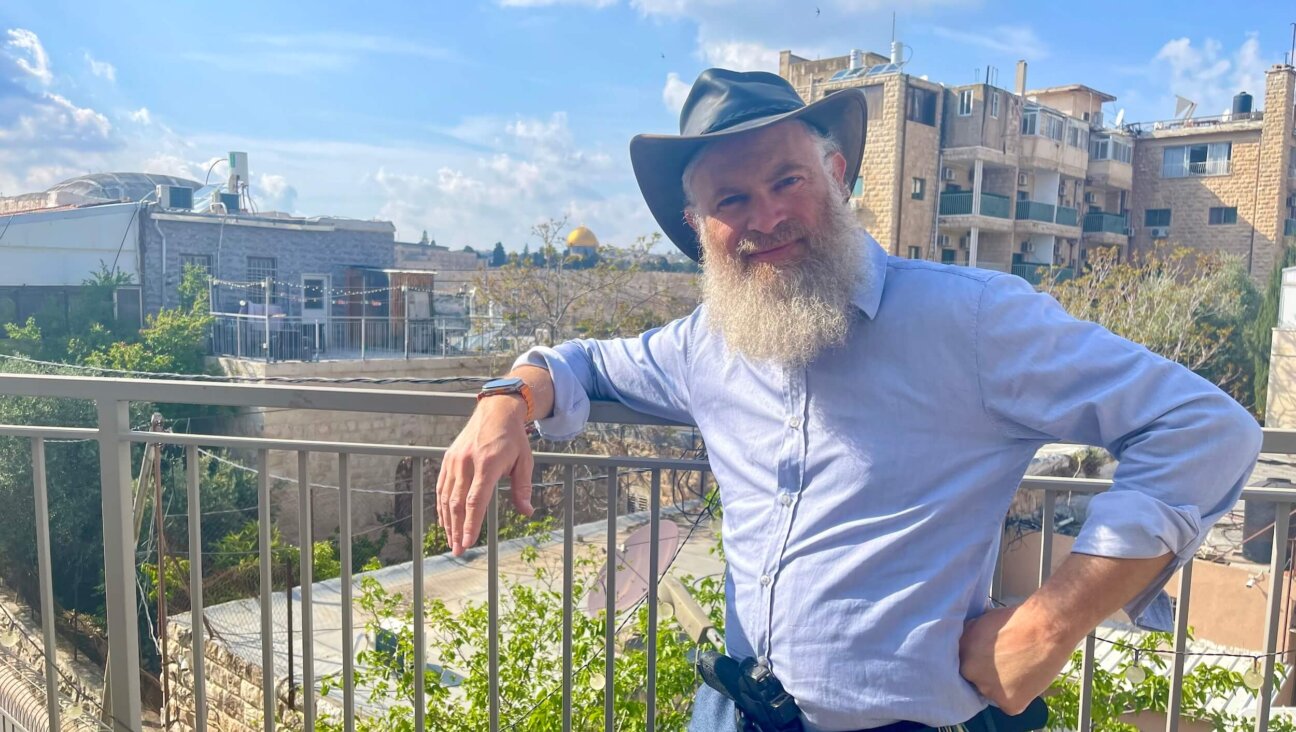Chabad vs. Chabad: Rabbis Duel in Ukraine
KIEV, Ukraine – Since assuming the title of chief rabbi of Ukraine last fall, Moshe Reuven Azman has hosted Ukraine’s president, helped negotiate American-Ukrainian trade deals and invited Israeli soldiers to his Kiev synagogue.
All of this might appear to be a big step forward for the Brooklyn-based Orthodox Hasidic sect that trained Azman, Chabad Lubavitch. Known to most American Jews for its friendly, bearded rabbis, Chabad had already locked up the position of chief rabbi of Russia in 2002. Having one of its own appointed as the top religious figure in Ukrainian Jewish life, however, has proven to be a bit more complicated.
Another Chabad rabbi, as it so happens, could already lay claim to the title.
Azrael Haikin was elected Ukraine’s chief rabbi in 2003 by a convention of local Ukrainian rabbis, most of them associated with Chabad. When Azman claimed the chief rabbi title in 2005, he was derided by many of his Chabad colleagues. Since then, the two sides have bickered over Ukraine’s Jewish resources, including a weekly one-hour Jewish slot on Ukrainian national television.
Beyond making for a high-profile internecine spat, the competition between two Chabad-trained Ukrainian chief rabbis highlights the sheer power of the Hasidic sect in the Jewish life of the former Soviet Union. Chabad began expanding into the former Soviet Union even before the Iron Curtain came down. During the first post-Communist years the expansion was marked by run-ins with other Jewish movements vying for the same turf, but by now Chabad’s position has become so dominant that its most high-profile problems come from some of its own rabbis.
In Moscow, the chief rabbi of Russia, a Chabad member who is close with President Vladimir Putin, has found himself in tangles with a pesky Chabad rabbi who has lined up independent funders. In Kiev, the competition is between the 40-year old Azman, who was trained in Chabad’s Israeli schools, and the 75-year old Haikin, who was trained in New York.
“Chabad is becoming the dominating force,” said Josef Zissels, the head of Ukraine’s secular Jewish council, or Vaad. “They’re not a monopoly, but they are a quasi-monopoly.”
Even before the current pair took the stage, Ukraine did not lack for chief rabbis. Rabbi Yakov Bleich, who is affiliated with the Karlin Stolin Orthodox movement, assumed the mantle of chief rabbi of Ukraine in 1992, and still holds that title and influence today. A rabbi from the Reform movement, the largest Jewish movement in the United States, calls himself chief Reform rabbi of Ukraine. But whereas those other movements combined have four rabbis in Ukraine, Chabad boasts close to 60. The non-Chabad rabbis frequently express a grudging respect for the expansion of Chabad in the region.
“Many, including my own movement, expected that if we just offered Jews a wonderful way of life we would get some foothold,” said Rabbi Michael Farbman, who is the Reform rabbi in St. Petersburg, Russia. “Chabad also remembered to go out there and buy buildings and build infrastructure and hire staff.”
But Chabad’s relations with other movements in Ukraine are not built only on admiration. The Reform rabbi in Kiev, Alexander Duchovny, said that rabbis from his movement have often been intimidated when working in cities with a Chabad presence. In the early post-Communist days, he said, the Reform movement registered communities in a number of smaller cities, only to watch Chabad rabbis who came in and “paid off the lay leaders” to switch their affiliation to Chabad.
Mayer Stambler, chairman of the Federation of Jewish Communities in Ukraine, acknowledged that some communities did switch affiliation and that, unlike the Reform, his organization does pay the lay leaders of its communities. But, Stambler added, the payments are meant to compensate for the time that these lay leaders give to the congregation.
Bleich, the Karlin Stolin chief rabbi, simply stated that Chabad “comes with so much money that there are very few locals who can stand up to them.”
Some have questioned what all the fighting is for, given that Ukraine has a dwindling population of Jews, numbering less than 200,000, most of whom are unaffiliated. Chabad’s philosophy, however, has always been about reaching the most unaffiliated of Jews, which would seem to make it perfectly suited for the work in the former Soviet Union.
The divisions within Chabad are partially a result of the sect’s success in winning over locals, at least among the wealthier strata. The federation of Chabad rabbis that elected Haikin as chief rabbi is bankrolled by the Uzbeki-Israeli diamond dealer Lev Leviev. Azman has cultivated his own sponsor in Ukraine: the arms dealer and media magnate Vadim Rabinovich. It was Rabinovich’s United Jewish Community of Ukraine that elected Azman chief rabbi last fall.
Now there are the debates about who makes more sense in the leadership position. Azman grew up in the Soviet Union and at 40, has a way with the younger generation. Haikin, by contrast, did not live in Ukraine until he was elected chief rabbi, and this year he was not in the country for the High Holy Days. But the rabbis who elected him say they were looking for the wisdom of age, not local know-how.
“After more than 10 years of establishing community we need answers to rabbinical questions,” said Stambler, the head of the Chabad federation in Ukraine. “Now after there are so many rabbis we realize we need a real rabbi who we can look up to.”
Stambler dismissed the suggestion that Azman could be that person.
“Rabbi Azman is a very nice guy, but he can’t be a rabbi,” Stambler said. “He never learned more than two years in a yeshiva.”
Sitting in his Kiev office, under a picture of himself with Ukraine’s president, Azman defended his learning in Israel and pointed to the struggle he went through to reach his current position. Azman grew up in St. Petersburg and learned about Judaism in an underground yeshiva. After a stint in Israel, Azman came to Kiev and began leading services in a basement room of the historic Brodsky Synagogue, which had been turned into a puppet theater during the Soviet era. Azman eventually pushed Rabinovich to build a new puppet theater so that he could take over the entire synagogue.
The Rabinovich-backed United Jewish Community says that Azman is the right man for the job.
“Azman is open minded — the modern person,” said Eduard Dolinsky, the organization’s executive director. But, he added, “these days there are different Chabads.”
Nathaniel Popper traveled to Ukraine on a World Affairs Journalism Fellowship administered by the International Center for Journalists. The Fellowship is funded by the Ethics and Excellence in Journalism Foundation.

I hope you appreciated this article. Before you go, I’d like to ask you to please support the Forward’s award-winning journalism this Passover.
In this age of misinformation, our work is needed like never before. We report on the news that matters most to American Jews, driven by truth, not ideology.
At a time when newsrooms are closing or cutting back, the Forward has removed its paywall. That means for the first time in our 126-year history, Forward journalism is free to everyone, everywhere. With an ongoing war, rising antisemitism, and a flood of disinformation that may affect the upcoming election, we believe that free and open access to Jewish journalism is imperative.
Readers like you make it all possible. Right now, we’re in the middle of our Passover Pledge Drive and we need 500 people to step up and make a gift to sustain our trustworthy, independent journalism.
Make a gift of any size and become a Forward member today. You’ll support our mission to tell the American Jewish story fully and fairly.
— Rachel Fishman Feddersen, Publisher and CEO
Join our mission to tell the Jewish story fully and fairly.
Our Goal: 500 gifts during our Passover Pledge Drive!























